I have very vivid memories as a child of waking up in the early morning and peering out the window, becoming both excited and hopeful to see the outside world coated with snow. I would then scramble to my parent’s room with bated breath, hoping that my father would wave me away with a frustrated huff and the knowledge that school had been canceled. Admittedly, sometimes even the threat of snow was enough to cancel school, an overreaction that was funny until these past few winters haven’t even brought enough of a threat for that. Snow days were the best kind of days, unplanned little vacations with the guarantee of a fun time and enough hot chocolate to either warm us from the insides or make us slightly sick.
Obviously, I am unable to experience the same type of snow day experience as a college student and debatably functioning adult. However, the inches and inches of snow and intensely cold winters have been lacking for the past few years. Winters in Virginia were never quite as powerful as, say, New York, but they could still pack a punch, and that has definitely changed within the past years. It’s been a while since we’ve experienced a snowstorm powerful enough to warrant anything beyond a couple of hours spent waiting for the snowplows to go through.
I miss stepping outside and having no choice but to change from sneakers into snow boots. I miss hints of snow as early as October, winter nipping at autumns heels. I even miss my father placing an oversized shovel in my childhood hands and demanding I go do (a very mediocre) job of scrapping down our sidewalk. The frozen rain and occasional unimpressive slush of the past few years just haven’t been the same.
So, who do we have to blame for this change? There are several possible reasons, but the main one seems to be global warming. I’m sure this comes as a surprise to no one. An overall global increase in temperature would obviously affect the winters here, but the change is still incredibly concerning. Surprisingly, it isn’t as simple as global warming causing less snow overall. Over the last 50 years, the amount of snowfall prior to December of 2018 decreased across the US, regardless of region.
However, after March 2019, snowfall was only shown to decrease in regions except for the Northeast. Winters have shown to have more snow in northern parts of the US, while there has been a definite decrease in the southern regions. Unfortunately for our snow days, Virginia happens to fall in this southern category. Outside of just winter snowfall, one of the clearest trends to emerge is that snowfall has decreased across the US in the “shoulder” seasons, fall and spring. It is now much rarer to experience early or late snowfall, and if it does take place, the storms are usually concentrated in the smaller time period of winter.
Winters are the fastest-warming season within the US, and although it would make sense that this increase in temperature would result in either more rain/less snow and faster melting rates, global warming actually also can cause the more counterintuitive effect of colder regions experiencing more snow. This is due to warmer air holding more moisture than cold air, meaning that any extra moisture in the air can fall as snow if it is to storm, even if the temperature is below freezing.
So, why does this change in temperature, specifically on snow patterns, matter? There are a myriad of reasons, but since the world becoming warmer has actually resulted in both an increase and decrease of snowfall (depending on the US region), we get the cons from both instead of just one. In terms of less snowfall, areas that used to have a high albedo (the reflectivity and presence of snow), especially during the springtime, now don’t provide as much of that reflective.
This is potentially damaging because high albedo in the Northern Hemisphere is responsible for reflecting solar energy back into the atmosphere in a way that dark forests and trees cannot. This cools down the planet, and when you remove this snow, the ground simply absorbs this heat instead, further contributing to global warming. It is a lovely and incredibly frustrating cycle. In terms of more snowfall, large or particularly intense snowstorms can be incredibly damaging both economically and to nearby communities. According to NOAA’s tracking, since 2000, six winter storms have caused over $1 billion in damage. There are other reasons, but these are just a couple.
Beyond the worldwide damage and never-ending cycle of global warming and its effect on snowfall, I must bring it back to what would have really been important to 10 year old me, the snow days. In the scheme of things, this isn’t really important, but whether we look at it from a micro or macro perspective, global warming really has been f*cking with our snow in a way that hurts all and benefits no one.



